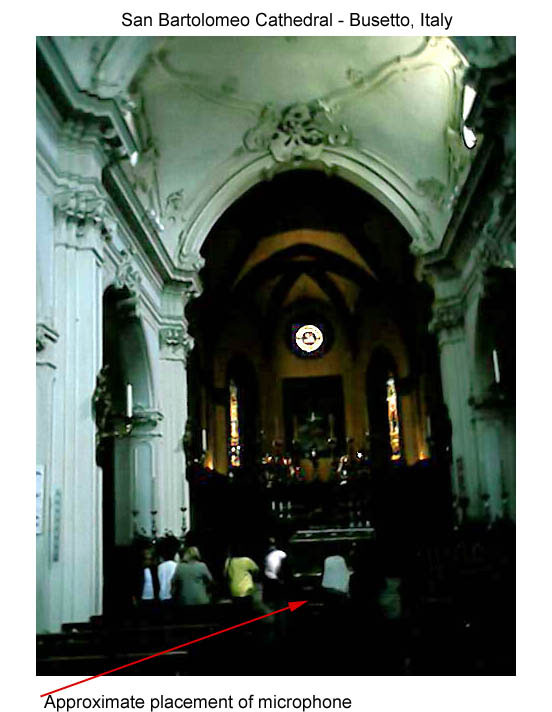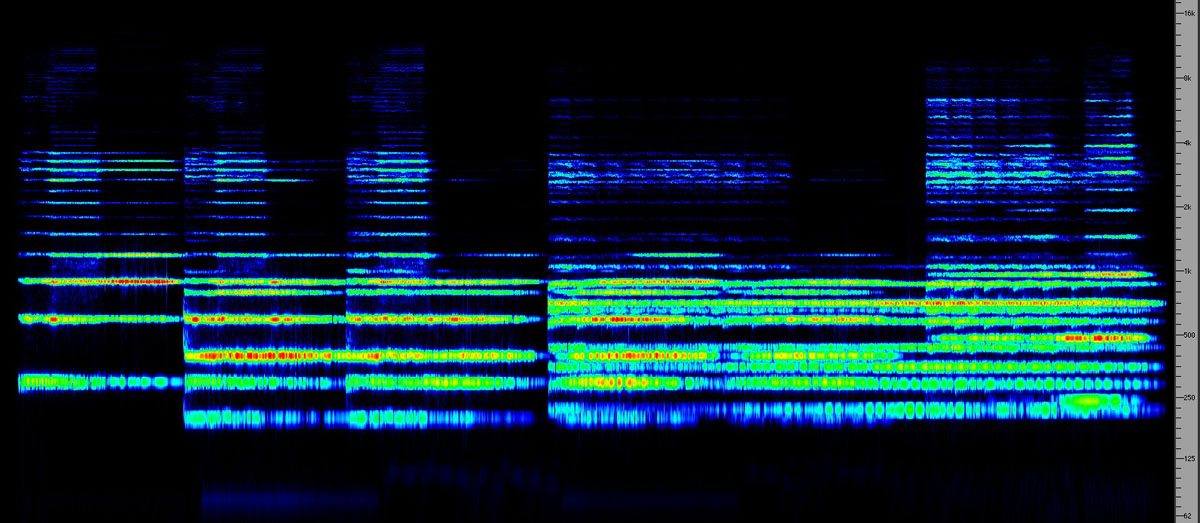Original voice recordings by counter-tenor
David Garfinkle, alto Sue McGowan, and bass Derrick Christian.

Note: the 16- and 8-channel versions of this work were created with Richmond Sound Design's AudioBox computer-controlled diffusion system.
Temple is available on the Cambridge Street Records CD, Spirit Journies. A complete documentation analysis of the work is also available on the WSP Database (contact Barry at truax@sfu.ca for guest password).

Spectrogram
Analysis
from the opening section of the work
Note: Sung
notes from 3 singers are used separately or digitally mixed
into chords, each of which is convolved
with the impulse response from Busetto Cathedral. All of
these materials are also auto-convolved (i.e. convolved with
itself) which lengthens the sound by a factor of two, and
removes weak spectral components. The effect is a sound that
is half way between the original voice and the reverberation
of the cathedral. In the production score every track
with the voice convolved with the impulse response is paired
with its auto-convolved version (which is also convolved
with the impulse response), thereby producing the "ghostly
after-image" referred to in the notes. The spectrum of each
chord and its after-image can be seen in the above
spectrogram. A complete documentation of all materials,
convolutions, tracks and spectrograms is available on the
WSP Database (contact Barry at truax@sfu.ca for guest
password).
![]() Sound Example available
Sound Example available
Reviews:
"Temple is composed of sounds made by three vocalists inside the cathedral of San Bartolomeo in Busetto, Italy. Rather than emphasizing the human texture of these voices, Truax's piece takes us on a tour of the cathedral's reverberatory nooks and ambient crannies, focusing on the interplay between voice, space, and object. The disembodied yet perceptibly human tones created through this process results in a thoughtful exploration of the human spirit, and a study of that spirit's ability to reach beyond the confines of the body when inspired by sacred space." Kristiana Clemens, Musicworks, 88, 2004.
The work was mainly realized using Tom Erbe's SoundHack convolution program, with additional material provided by the composer's PODX system which incorporates the DMX-1000 Digital Signal Processor controlled by a PDP Micro-11 computer with software for real-time granular synthesis and signal processing (such as digital resonators) developed by the composer in the School for the Contemporary Arts at Simon Fraser University. The sounds were recorded on 8-track digital tape and the AudioBox, and mixed in the Sonic Research Studio at SFU. Original impulse response file (of San Bartolomeo Cathedral, in Busseto, Italy) provided by Worldwide Soundspace library, some of which is now available in Peak's "Impulseverb" for OSX.